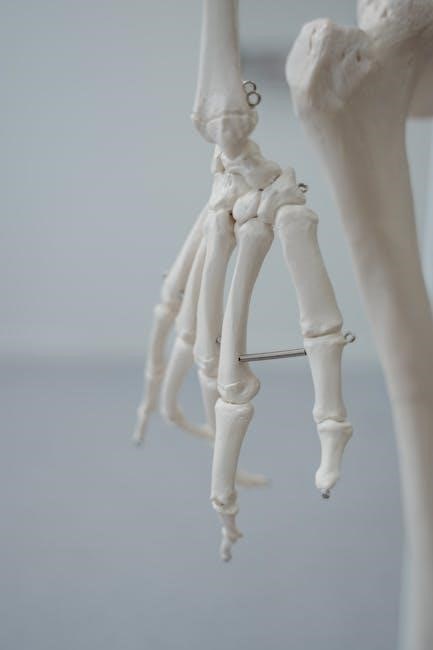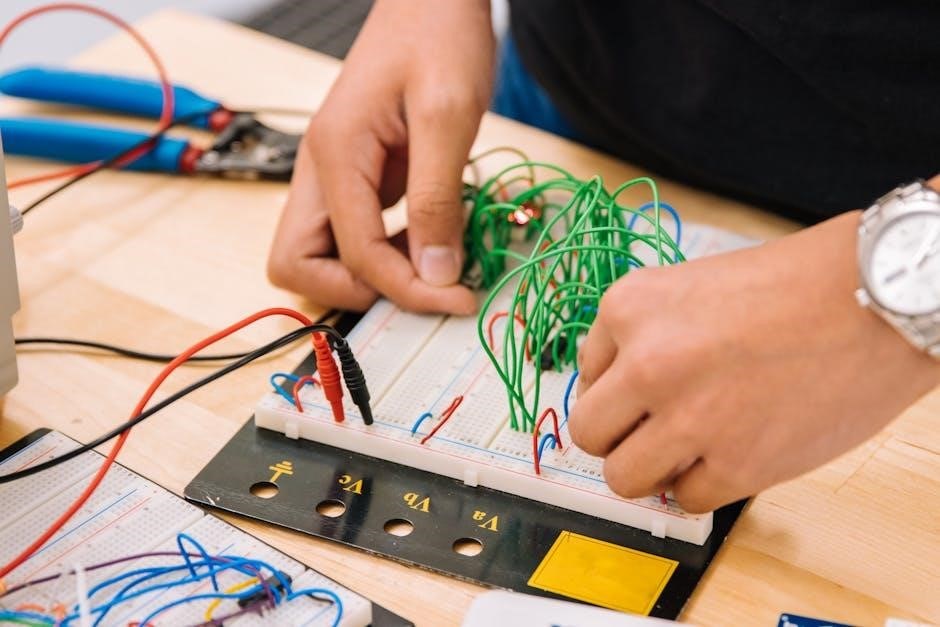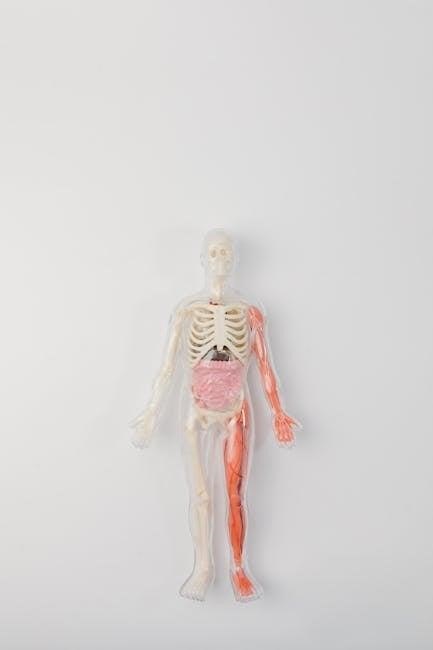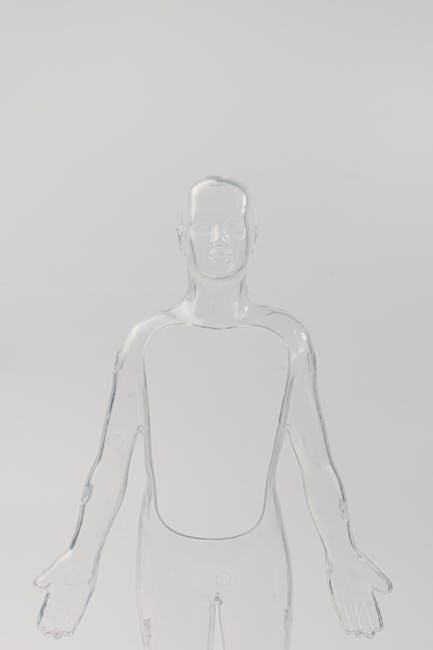
essentials of human anatomy and physiology lab manual
This lab manual is a practical guide to understanding human anatomy and physiology concepts. It introduces students to key concepts with experiments.
Overview of Lab Manuals in A&P
Lab manuals for Anatomy & Physiology (A&P) are essential tools for students, providing hands-on experience and reinforcing theoretical knowledge. These manuals typically feature a variety of experiments designed to enhance understanding of the human body’s structure and function. They often incorporate visual aids, such as diagrams and photographs, to help students visualize anatomical structures. Many A&P lab manuals are specifically designed for students in healthcare programs, focusing on topics relevant to clinical practice. They also include pre- and post-lab activities to prepare students and assess their comprehension. Some manuals offer digital resources and online integration, such as Mastering A&P, to provide additional learning support. Different versions cater to various needs, including main versions and dissection manuals for cat or fetal pig dissections. Overall, A&P lab manuals aim to make learning engaging and effective, fostering a deeper understanding of the subject matter through practical application.

Key Features of Anatomy & Physiology Lab Manuals
A&P lab manuals offer hands-on experiments, visual aids, and healthcare connections. They engage students and reinforce concepts effectively.
Hands-on Experiments
Anatomy and Physiology lab manuals prioritize hands-on experiments to enhance student learning. These experiments actively engage students, moving beyond passive observation to active participation in the learning process. By directly interacting with anatomical models, conducting physiological tests, and performing dissections (where applicable), students develop a deeper and more intuitive understanding of the subject matter. Hands-on activities reinforce theoretical concepts presented in lectures and textbooks, making abstract ideas more concrete and relatable. These experiments often involve real-world scenarios and applications, further solidifying students’ comprehension and retention of the material. Moreover, these exercises cultivate critical thinking, problem-solving, and analytical skills, preparing students for future challenges in healthcare and related fields. The use of BIOPAC exercises, for example, allows for the direct measurement and analysis of physiological parameters, providing a tangible connection between theory and practice. Ultimately, hands-on experiments in A&P lab manuals are crucial for fostering a comprehensive and lasting understanding of the human body.
Visual Aids and Artwork
Visual aids and artwork are integral to effective Anatomy and Physiology lab manuals, playing a crucial role in facilitating comprehension and retention of complex anatomical structures and physiological processes. High-quality illustrations, diagrams, and photographs provide students with a visual representation of the human body, allowing them to visualize and understand the spatial relationships between different organs, tissues, and systems. Detailed anatomical drawings, often sourced from renowned publications, offer clear and accurate depictions of internal structures, aiding in identification and memorization. Furthermore, visual aids can simplify complex physiological concepts by illustrating processes such as cellular respiration, muscle contraction, and nerve impulse transmission. The use of color-coded diagrams and flowcharts further enhances clarity and understanding. Moreover, many lab manuals incorporate interactive visuals, such as 3D models and animations, which allow students to explore anatomical structures from different perspectives and visualize dynamic physiological processes in real-time. By providing a multi-sensory learning experience, visual aids and artwork cater to different learning styles and enhance the overall effectiveness of the lab manual. Visual aids and artwork are also a great way to engage students and capture their attention, making the learning process more enjoyable and effective.
Connection to Healthcare Programs
Anatomy and Physiology (A&P) lab manuals are intrinsically linked to healthcare programs, serving as a cornerstone in the education and training of future healthcare professionals. These manuals provide students pursuing careers in medicine, nursing, physical therapy, and other allied health fields with a foundational understanding of the human body’s structure and function. The hands-on experiments and activities within A&P lab manuals allow students to apply theoretical knowledge to real-world scenarios, developing critical thinking and problem-solving skills essential for clinical practice. The focus on anatomical structures and physiological processes enables students to comprehend the underlying mechanisms of disease and injury, paving the way for effective diagnosis and treatment strategies. Furthermore, A&P lab manuals often incorporate clinical case studies and scenarios, bridging the gap between the laboratory and the healthcare setting. These case studies challenge students to apply their knowledge to patient-specific situations, fostering clinical reasoning and decision-making abilities. The emphasis on practical skills, such as microscopy, dissection, and physiological measurements, equips students with the technical proficiency required for various healthcare procedures. Ultimately, A&P lab manuals lay the groundwork for students to excel in their chosen healthcare professions, enabling them to provide safe, effective, and patient-centered care. The lab manuals also help students develop a strong understanding of medical terminology and clinical practices.

Common Topics Covered
A&P lab manuals cover topics like microscopy, tissue ID, and anatomical models. They help students understand the human body in a practical way.
Microscopy and Cellular Structures
This section of the anatomy and physiology lab manual delves into the microscopic world, allowing students to explore the intricate structures of cells and tissues. Using microscopes, students will learn to identify different cell types, observe cellular organelles, and understand the functional significance of these structures. Exercises often include preparing slides, staining techniques, and detailed observation of various cell specimens. Students will also learn about cell division, cellular transport mechanisms, and the role of cells in maintaining homeostasis. This section provides a foundational understanding of cellular biology, which is essential for comprehending the complex functions of the human body. The lab activities are designed to enhance visual learning and critical thinking skills. Furthermore, students gain hands-on experience in using microscopes and preparing specimens, developing essential skills for future healthcare professionals. The content connects microscopic observations to macroscopic functions, bridging the gap between cellular processes and overall body physiology. The lab manual provides clear instructions and detailed diagrams to aid students in identifying and understanding cellular structures, fostering a deeper appreciation for the complexity and organization of life at the cellular level.
Tissue Identification
A crucial component of any anatomy and physiology lab manual is the section dedicated to tissue identification. This section focuses on enabling students to distinguish between the four primary tissue types: epithelial, connective, muscle, and nervous tissue. Through microscopic examination of prepared slides, students learn to recognize the unique characteristics of each tissue type, including cell shape, arrangement, and the presence of specialized structures. Detailed descriptions and high-quality images aid in the identification process. The lab manual provides exercises that challenge students to differentiate between subtypes within each major tissue category, such as squamous, cuboidal, and columnar epithelium, or dense regular, dense irregular, and loose connective tissue. Emphasis is placed on understanding the relationship between tissue structure and function, allowing students to appreciate how the arrangement of cells and extracellular matrix contributes to the overall role of the tissue in the body. Practical applications are often included, demonstrating how tissue identification is relevant in diagnosing diseases and understanding physiological processes. This section enhances students’ ability to analyze histological samples, a skill essential for various healthcare professions. Furthermore, the lab activities promote critical thinking and observational skills, fostering a deeper understanding of the body’s structural organization. By mastering tissue identification, students gain a solid foundation for comprehending the complex interactions between different tissues and organs within the human body.
Anatomical Models and Dissections
The use of anatomical models and dissections forms a cornerstone of human anatomy and physiology laboratory manuals. Anatomical models provide students with a tangible, three-dimensional representation of various body structures, allowing for detailed examination without the constraints of a cadaver or living subject. These models often highlight specific organs, skeletal structures, or vascular systems, enabling students to visualize complex anatomical relationships. The lab manual guides students through the identification of key features on each model, reinforcing their understanding of anatomical terminology and spatial orientation. Dissections, on the other hand, offer a hands-on approach to exploring the body’s internal organization. Whether it involves dissecting a whole animal or focusing on specific organs, the manual provides step-by-step instructions and clear illustrations to guide students through the process. Safety protocols are emphasized, ensuring a safe and respectful learning environment. Through dissection, students gain a deeper appreciation for the intricate connections between different body systems, as well as the variations in anatomical structures. The lab manual also includes pre- and post-dissection activities, such as labeling diagrams and answering review questions, to reinforce learning. Furthermore, the manual encourages critical thinking by asking students to make observations, draw conclusions, and relate anatomical findings to physiological functions. The combination of anatomical models and dissections provides a comprehensive and engaging learning experience, promoting a deeper understanding of the human body’s structure and function. This practical approach is essential for students pursuing careers in healthcare and related fields, as it fosters both visual and tactile learning, enhancing their ability to apply anatomical knowledge in real-world scenarios.

Types of Lab Manuals
Lab manuals vary: main versions cover general A&P topics. Others focus on dissections like cats or fetal pigs, offering specialized exercises.
Main Version Lab Manuals
These manuals are the cornerstone of anatomy and physiology laboratory education, providing a comprehensive overview of the human body’s structures and functions. They are designed to complement standard A&P textbooks and offer a wide array of exercises that cover all major organ systems. Students using main version lab manuals will engage in activities ranging from microscopy of tissues to physiological experiments that demonstrate principles of homeostasis. The exercises are structured to reinforce lecture material and promote critical thinking skills. Main version manuals often include pre-lab quizzes, step-by-step procedures, and post-lab questions to ensure students understand the concepts and can apply them to real-world scenarios. Many incorporate visual aids, such as anatomical drawings and photographs, to help students visualize complex structures. These manuals are essential for students pursuing careers in healthcare, providing a foundation for understanding the human body in both health and disease. Furthermore, they frequently integrate with online resources, offering interactive simulations and assessments to enhance the learning experience, ensuring students are well-prepared for future studies and professional practice.
Cat and Fetal Pig Dissection Manuals
These manuals provide a hands-on approach to learning anatomy through dissection, offering a unique and invaluable experience for students. Dissection manuals focus on the anatomy of cats or fetal pigs, which serve as excellent models for understanding human anatomy due to the similarities in organ systems and structures. These manuals guide students through the dissection process with detailed, step-by-step instructions, clear diagrams, and photographs to ensure accurate identification of anatomical structures. The dissection exercises promote a deeper understanding of spatial relationships and the three-dimensional arrangement of organs within the body. Students learn to identify muscles, bones, blood vessels, nerves, and internal organs, enhancing their ability to visualize and comprehend complex anatomical concepts. Cat and fetal pig dissection manuals often include comparative anatomy sections, highlighting the similarities and differences between the animal model and human anatomy. This comparative approach reinforces learning and helps students appreciate the evolutionary relationships between species. Furthermore, these manuals typically include review questions and practical exam preparation to assess student understanding and readiness for assessments. These resources are indispensable for students pursuing careers in medicine, veterinary science, and other allied health professions, providing a solid foundation in anatomical knowledge and dissection skills.

Digital Resources and Online Integration
Digital resources enhance A&P lab manuals, offering interactive tools like Mastering A&P. Online platforms provide virtual labs and supplementary materials.
Mastering A&P Integration
Mastering A&P serves as a powerful online homework and learning program designed to work in tandem with Human Anatomy & Physiology lab manuals. It provides students with an array of interactive tools and resources to enhance their understanding of complex anatomical structures and physiological processes. These tools often include interactive physiology tutorials, focus figure mini-animations, and customizable Practice Anatomy Lab (PAL) modules. Mastering A&P helps students engage with the material outside of the lab setting, reinforcing key concepts and improving their overall performance. It also offers instructors a way to track student progress and identify areas where students may need additional support. Through its integration with lab manuals, Mastering A&P addresses the challenge of getting students to prepare for labs, actively participate during labs, and effectively apply the concepts learned in the lab to real-world scenarios, particularly in healthcare programs. The platform’s features are designed to promote active learning and critical thinking, making it an invaluable resource for both students and instructors in A&P courses.
Online Lab Manuals and Resources
Online lab manuals and resources are increasingly becoming essential components of modern anatomy and physiology education. These digital resources offer a flexible and accessible alternative to traditional print manuals, providing students with a wealth of interactive tools and multimedia content to enhance their learning experience. Many institutions now offer free online lab manuals, such as the BIOL 2210L lab manual, which is licensed under a Creative Commons Attribution-NonCommercial 4.0 International License. These resources often include virtual microscopy tools, allowing students to examine cellular structures and tissues without the need for physical microscopes. Additionally, online platforms may feature interactive simulations, 3D models, and videos that demonstrate complex anatomical and physiological processes. The integration of online resources helps address common challenges in A&P education, such as engaging students in the lab, preparing them for lab activities, and facilitating the application of concepts. Furthermore, digital manuals can be easily updated and customized, ensuring that students have access to the most current and relevant information. This shift towards online resources supports a more dynamic and engaging learning environment, ultimately improving student outcomes in anatomy and physiology courses.